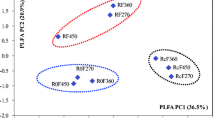Abstract
Liming costs have escalated since the mid 1970's in the United States. Studies of crop response to lime with irrigation are limited as well as those of crop response to soil acidifying agents. This study was conducted to determine yield response of irrigated soybean [Glycine max (L.) Merrill], corn (Zea mays L.), and wheat (Triticum aestivum L.) to lime and S and the change in soil pH, in response to lime and S. Irrigated soybean, corn, and wheat were grown on Dothan and Tifton loamy fine sand (Plinthic Acrisols) with different levels of calcite, dolomite, and S. Soil samples were collected before applying treatments and during each growing season. Soil pH and Mehlich I extractable P, K, Ca, and Mg in addition to grain yield of each crop were determined. Highest soybean yield (4.2 t ha−1) occurred in 1984 at a soil pH of 4.9 (1:1 v/v soil—water suspension) while the yield was zero at a pH of 3.7 on S treated plots. A soil pH of 4.8 in 1985 reduced soybean yield from 3.4 to 2.7 t ha−1 in comparison to untreated plots (pH = 5.6). In 1986, soybean yield was 0.8 t ha−1 at pH 4.0 in comparison to 2.3 t ha−1 at pH 5.1 and 5.9. Corn did not respond to lime with control pH of 5.3 in 1985 or 5.1 in 1986 but S at pH 4.6 reduced yield from 12.3 to 8.7 t ha−1 in 1985 and S reduced yield from 11.0 to 0.9 t ha−1 at pH 4.0 in 1986. Sulfur reduced wheat yield from 4.3 to 1.7 t ha−1 in 1985 and from 2.2 to 0.9 t ha−1 in 1987. Soil pH after cropping with S addition was 4.4 each year. Wheat did not respond to lime when unlimed soil had a pH of 5.2 or above.
Similar content being viewed by others
References
Adams F (1984) Crop response to lime in the southern United States.In Adams F (ed) Soil acidity and liming. Agron No. 12, Madison, WI: Am Soc Agron
Alley MM (1981) Short-term soil chemical and crop yield responses to limestone applications. Agron J 73: 687–789
Barnett RD and Luke HH (1980) Florida 301, a new wheat for multiple cropping systems in North Florida. Univ of Fla Inst Food and Agric Sci Cir. S-273
Buol SW, Hole FD and McCracken RJ (1980) Soil genesis and classification. Ames: Iowa State Univ Press
Farina MPW, Sumner ME, Plank CO and Letzsch WS (1980) Exchangeable aluminium and pH as indicators of lime requirements for corn. Soil Sci Soc Am J 4: 1036–1041
Johnson GV, Isaac RA, Donohue SJ, Tucker MR and Woodruff JR (1984) Procedures used by state soil testing laboratories in the southern region of the United States. Southern Coop Series Bulletin No. 190
Kamprath EJ (1970) Exchangeable aluminium as a criterion for liming leached mineral soils. Soil Sci Soc Am Proc 34: 252–254
McLean EO (1970) Lime requirements of soils — Inactive toxic substances or favorable pH range? Soil Sci Soc Am Proc 34: 363–364
Ohki K (1987) Aluminium stress on sorghum growth and nutrient relationships. Plant and Soil 98: 195–202
Rhoads FM (1975) Influence of soil amendments on chemical and physical properties of cigar-wrapper tobacco. Tob Sci XIX: 107–110
Steel RGD and Torrie JH (1960) Principles and procedures of statistics. New York: McGraw-Hill
Sumner ME (1984) Georgia liming recommendations. Univ of Georgia Mimeo Report
Author information
Authors and Affiliations
Rights and permissions
About this article
Cite this article
Rhoads, F.M., Manning, A. Soybean, corn, and wheat yields with variable soil pH on Plinthic Acrisols. Fertilizer Research 19, 137–142 (1989). https://doi.org/10.1007/BF01054455
Received:
Accepted:
Issue Date:
DOI: https://doi.org/10.1007/BF01054455




